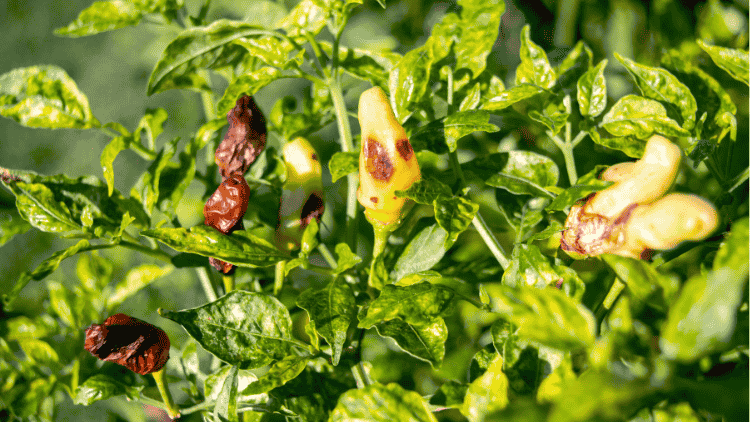
Fungal Diseases in Plants: Early Signs and Organic Fungicide Solutions
Share
Growing healthy crops is the top priority of every farmer, as they play a key role in agriculture by providing food, supporting the economy, and protecting the environment. Farmers depend largely on successful harvests to supply food, nourish people, and sustain their livelihoods.
However, growing healthy crops is a daunting challenge due to pests and diseases, with fungal infections being one of the biggest threats for farmers.
Fungal diseases in plants can destroy the healthiest foliage if left unchecked. They can hinder plant growth, reduce yields, affect crop quality, and sometimes even destroy entire fields. Thankfully, the solution does not always lie in harsh chemicals.
Nature itself offers powerful remedies, and organic fungicide for plants are emerging as a preferred choice among farmers looking for 100% natural solutions.
In this blog post, we’ll dive deep into the most commonly occurring fungal infections in plants, the early signs to identify them easily, and what organic fungicide solutions you can use to effectively fight these diseases and ensure healthy crops.
What are Fungal Diseases in Plants?
Plant fungal diseases are caused by a wide range of microscopic organisms called fungi that infect plant tissues and interfere with water transport, nutrient uptake, and photosynthesis. These pathogens typically thrive in warm and humid conditions and can spread through air, soil, water, and contaminated tools.
Fungi can affect every part of a plant, including leaves, stems, roots, fruits, and even seeds. Their invisibility in the initial stages makes them particularly dangerous, often only showing signs after significant internal damage. Unlike bacteria or viruses, fungi produce spores that can survive for years even in unfavorable conditions.
Common Fungal Diseases in Plants
Numerous fungal diseases affect different types of plants worldwide, both in agricultural fields and on local farms. For farmers aiming to grow healthy crops and get high-quality yields, understanding these diseases is important to identify them and implement effective plant fungus treatment, while keeping the environment safe.
The following are some of the commonly occurring fungal diseases in crops:
Powdery Mildew
This disease is characterized by the formation of a white or gray powdery coating on leaves, stems, and buds. It results in stunted growth and leaf drops if not treated with a fungicide spray. It mainly affects crops like grapes, cucumbers, and wheat.
Downy Mildew
Often confused with powdery mildew, this disease appears as yellow or white patches on the upper side of leaves and grayish mold on the underside. It thrives in cool, damp conditions and commonly affects lettuce, onions, and spinach.
Rust
Yes, rust is a common plant disease, too. It appears as rusty, orange, or brown pustules on the undersides of leaves. If not treated effectively with an organic fungicide for plants, this disease can weaken the plants and reduce growth.
Fusarium Wilt
Fusarium wilt is caused by a soil-borne fungus that clogs a plant’s water-conducting vessels, leading to yellowing and wilting of leaves. It is a slow killer and can live in soil for years. This disease affects crops such as bananas, tomatoes, and cotton.
Early and Late Blight
A major fungal disease mainly affecting tomato and potato plants is blight. It starts with dark spots and spreads rapidly, leading to defoliation and fruit rot. Effective tomato blight treatment is crucial to saving crops and ensuring maximum yield.
Early Signs to Identify Fungal Diseases in Plants
Catching plant fungal diseases early is the most effective way to prevent them from spreading. Since fungal infections spread quite quickly, identifying them with their early signs helps you safeguard your crops by implementing the most effective plant fungus treatment. Thus, you must know what these early signs exactly are.
Here are some of the most prominent ones that you should look out for;
White or Gray Mold
The most common early sign of fungal diseases in plants is the formation of white or gray mold on leaves and stems. These formations are especially observed in humid conditions and generally indicate mold-based fungal infections.
Spots and Discoloration
Look for brown, yellow, or black spots on leaves, often with concentric rings or irregular borders. These are classical signs of fungal diseases affecting leaves. Some fungal infections may discolour leaves completely rather than forming spots.
Leaf Curling and Distortion
Curled, twisted, or wilted leaves might be more than just a symptom of heat stress; they can also indicate an internal fungal infection. Leaf distortion is a common symptom of blight in tomatoes and often requires tomato blight treatment.
Sudden Wilting
When a plant wilts even though it’s well-watered, fungal root infection might be the cause. Inspect roots for a foul smell or mushy texture. If these symptoms are observed, consider removing the plant as root infections spread quite quickly.
Lesions on Stems and Fruits
Dark, sunken lesions on stems, fruit, or flowers can indicate advanced stages of fungal attack. Formation of such lesions completely stunts plant growth, but can be easily avoided with regular usage of fungicide spray on the crop.
Organic Solutions for Fungal Diseases in Plants
By now, you’ve learned about the commonly occurring fungal infections in plants and the symptoms to identify them in the early stages. But the most important thing is to know about effective, chemical-free treatments. Organic solutions are the most impactful against fungal diseases, with minimal environmental impact.
Let’s take a look at some organic, eco-friendly ways to tackle fungal infections in plants:
Organic Fungicide for Plants
Organic fungicide for plants is undoubtedly the best treatment to overcome existing fungal diseases in crops and safeguard plants from them in the future. Powerful organic fungicides, like Turmicide by Octa Organics, ensure long-term protection.
Neem Oil
Neem oil, derived from leaves of the neem tree, is a natural antifungal agent that disrupts the growth cycle of fungal cells. It can be diluted with water and then sprayed directly on plants to prevent diseases like powdery mildew and rust.
Sulfur Fungicide Spray
Widely accepted in organic farming, Sulfur is a natural fungicide that helps control powdery mildew, rust, and black spots. A solution of Sulfur mixed with water can be used as a fungicide spray to control downy mildew, rust, and black spots.
Baking Soda Solution
Baking soda mixed with water (1 tablespoon in 1 gallon of water) and a mild soap can create an alkaline environment that inhibits fungal growth. This homemade treatment is useful for managing early-stage infections and blights.
Garlic Extract
Garlic contains sulfur compounds that have strong antifungal properties. Crushed garlic diluted with water can be sprayed to suppress early fungal activity. Garlic extract is an effective tomato blight treatment and also prevents mold formation.
Fighting Fungal Diseases in Plants with Octa Organics
Protection against fungal diseases in plants doesn't always have to be implemented with chemical-based solutions, which are harmful to the plants, humans, and the environment. With the right knowledge about the common diseases, early signs, and effective organic treatments, every farmer can make sustainable choices.
Octa Organics, with the motive of promoting sustainable, chemical-free farming, proves that organic solutions are not only effective but also scalable and accessible. With our 100% natural plant fungus treatment products, every farmer can protect crops against harmful fungal diseases efficiently while nurturing nature.

